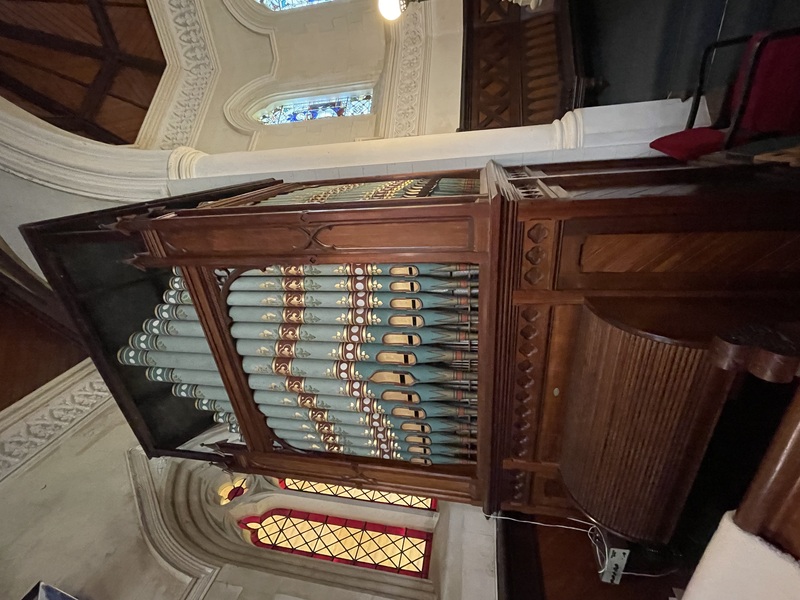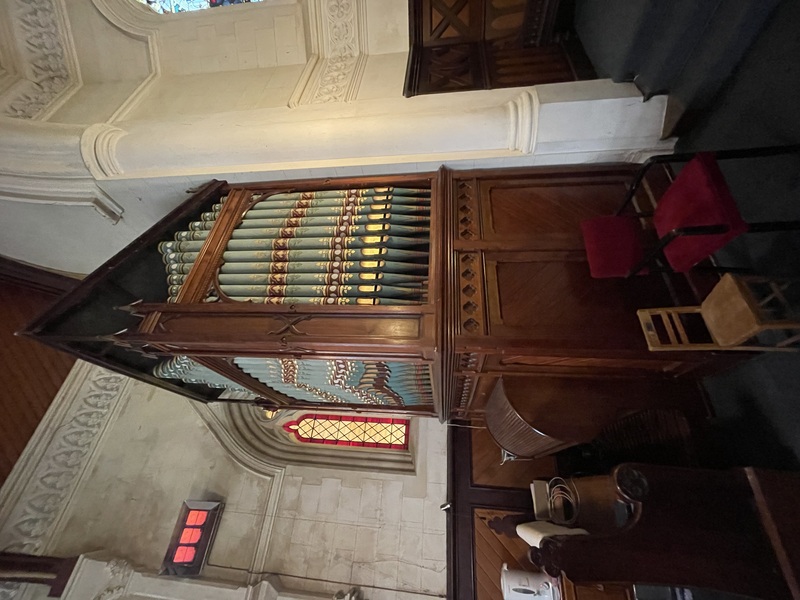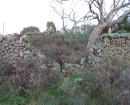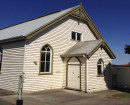Back to search results
FINCHAM AND HOBDAY PIPE ORGAN
954 LINTON-CARNGHAM ROAD SNAKE VALLEY, PYRENEES SHIRE
FINCHAM AND HOBDAY PIPE ORGAN
954 LINTON-CARNGHAM ROAD SNAKE VALLEY, PYRENEES SHIRE
All information on this page is maintained by Heritage Victoria.
Click below for their website and contact details.
Victorian Heritage Register
-
Add to tour
You must log in to do that.
-
Share
-
Shortlist place
You must log in to do that.
- Download report

2023. Carngham Church Fincham & Hobday Pipe Organ


On this page:
Statement of Significance
What is significant?
The Fincham & Hobday Pipe Organ, located at Carngham Memorial Church, is a two manual organ with tubular pneumatic action and featuring a rare example of Fincham’s slider less windchest design. It is a rare and intact example of the organ building work undertaken by Fincham & Hobday during their partnership. The organ features two perpendicular facades with elaborate stencilled facade pipes, and a substantial blackwood case that features gothic motifs including arch timber mouldings, quatrefoil carvings and pinnacles to the top of the organ case.
How is it significant?
The Fincham & Hobday Pipe Organ is of historical significance to the State of Victoria. It satisfies the following criterion for inclusion in the Victorian Heritage Register:
Criterion B
Possession of uncommon, rare or endangered aspects of Victoria’s cultural history.
Criterion F
Importance in demonstrating a high degree of creative or technical achievement at a particular period.
Criterion B
Possession of uncommon, rare or endangered aspects of Victoria’s cultural history.
Criterion F
Importance in demonstrating a high degree of creative or technical achievement at a particular period.
Why is it significant?
The Carngham Memorial Church Organ is a rare example of a Fincham & Hobday pipe organ, built with and retaining the slider less windchest/soundboard. Slider less soundboards were only introduced in a handful of organs including Carngham, the pedal soundboard at St Mary’s West Melbourne, and three organs in New Zealand. Despite being introduced in several pipe organs, difficulties with maintenance have resulted in many being dismantled and rebuilt since. The pipe organ is unaltered beyond the introduction of a cover to the top of the organ, and an electric blower, making it an extremely rare and intact example of Fincham’s soundboard design.
(Criterion B)
The Carngham Memorial Church Organ is technically and creatively significant for the innovation demonstrated by George Fincham’s use of a slider less windchest. The soundboard design to the organ demonstrates the innovation and experimentation undertaken by George Fincham within the Australian organ building industry and his application of European organ builders’ inventions within the Australian practice. The soundboard design was adopted by Fincham to counteract the climatic effects on timber soundboards, which were prone to cracking in the dry Australian climate. The survival of the Carngham Pipe Organ is a testament to the successful application of this soundboard design at a time before water or electricity guaranteed the constant supply of wind.
(Criterion F)
Show more
Show less
-
-
FINCHAM AND HOBDAY PIPE ORGAN - History
George Fincham came to Victoria in 1852 after a seven-year apprenticeship with Henry Bevington and found alternative work for twelve years until he had enough organ building commissions to sustain him. Arthur Hobday began as Fincham’s apprentice and by 1887 a partnership had formed.
The economic depression of the 1890s meant fewer organ commissions. The organ at Carngham by Fincham and Hobday was one of only two built in 1893 by the firm, though three new organs had been produced by Fincham’s factory the previous year and opened at their respective churches in the first four months of 1893. Arthur Hobday had visited to the newly opened church in September 1893 to discuss the positioning of the new organ (originally to be in the corner near the porch entrance) and in January 1894 the new organ was opened.
The Carngham pipe organ was built with tubular pneumatic action and slider less windchests, which was based on a principle used by German organ builders known as the Kegellade system. The Kegellade system was perfected and patented by prominent organ builder E. F. Walcker of Germany in 1842. Its application by George Fincham in Australia was an innovative solution to a persistent problem with timber soundboards in the Australian climate, where shrinkage across the wood grain would cause the sliders of ordinary soundboards to crack in hot and dry weather. Imported organs faced similar issues, often made in damp climates or exposed to high humidity and dampness during transportation, resulting in damage to otherwise high-quality organ work when exposed to the hot and dry Australian climate.
While the tubular pneumatic action features in many Fincham organ designs, very few organs with Fincham’s slider less windchests were made. Hobday appears to have exported the design to New Zealand, where three Fincham & Hobday organs were built with slider less windchests, however none of these have been retained. While the design worked initially, praised for having perfect responsiveness and quietness at the time, maintenance of the soundboard in later years proved difficult. The result is that most examples of this windchest have been rebuilt or replaced to streamline future maintenance.
Carngham is one of the only surviving examples of the slider less windchests, unaltered excepting the fitting of an electric blowing unit and an organ cover to prevent water damage. Until 1958, the church organ was pumped with bellows by men of the congregation, which proved problematic during WWII when there was a shortage of fit young men to do so. In 1960 Fincham & Sons electrified the organ. Major restoration of the pipe organ was undertaken in 1986 by Mr. Leighton Turner of Ballarat.FINCHAM AND HOBDAY PIPE ORGAN - Assessment Against Criteria
Criterion
The Fincham & Hobday Pipe Organ is of historical significance to the State of Victoria. It satisfies the following criterion for inclusion in the Victorian Heritage Register:Criterion B
Possession of uncommon, rare or endangered aspects of Victoria’s cultural history.Criterion F
Importance in demonstrating a high degree of creative or technical achievement at a particular period.
FINCHAM AND HOBDAY PIPE ORGAN - Permit Exemptions
General Exemptions:General exemptions apply to all places and objects included in the Victorian Heritage Register (VHR). General exemptions have been designed to allow everyday activities, maintenance and changes to your property, which don’t harm its cultural heritage significance, to proceed without the need to obtain approvals under the Heritage Act 2017.Places of worship: In some circumstances, you can alter a place of worship to accommodate religious practices without a permit, but you must notify the Executive Director of Heritage Victoria before you start the works or activities at least 20 business days before the works or activities are to commence.Subdivision/consolidation: Permit exemptions exist for some subdivisions and consolidations. If the subdivision or consolidation is in accordance with a planning permit granted under Part 4 of the Planning and Environment Act 1987 and the application for the planning permit was referred to the Executive Director of Heritage Victoria as a determining referral authority, a permit is not required.Specific exemptions may also apply to your registered place or object. If applicable, these are listed below. Specific exemptions are tailored to the conservation and management needs of an individual registered place or object and set out works and activities that are exempt from the requirements of a permit. Specific exemptions prevail if they conflict with general exemptions. Find out more about heritage permit exemptions here.Specific Exemptions:Specific Exemptions
The works and activities below are not considered to cause harm to the cultural heritage significance of the Carngham Memorial Church subject to the following guidelines and conditions:
Guidelines- Where there is an inconsistency between permit exemptions specific to the registered place or object (‘specific exemptions’) established in accordance with either section 49(3) or section 92(3) of the Act and general exemptions established in accordance with section 92(1) of the Act specific exemptions will prevail to the extent of any inconsistency.
- In specific exemptions, words have the same meaning as in the Act, unless otherwise indicated. Where there is an inconsistency between specific exemptions and the Act, the Act will prevail to the extent of any inconsistency.
- Nothing in specific exemptions obviates the responsibility of a proponent to obtain the consent of the owner of the registered place or object, or if the registered place or object is situated on Crown Land the land manager as defined in the Crown Land (Reserves) Act 1978, prior to undertaking works or activities in accordance with specific exemptions.
- If a Cultural Heritage Management Plan in accordance with the Aboriginal Heritage Act 2006 is required for works covered by specific exemptions, specific exemptions will apply only if the Cultural Heritage Management Plan has been approved prior to works or activities commencing. Where there is an inconsistency between specific exemptions and a Cultural Heritage Management Plan for the relevant works and activities, Heritage Victoria must be contacted for advice on the appropriate approval pathway.
- Specific exemptions do not constitute approvals, authorisations or exemptions under any other legislation, Local Government, State Government or Commonwealth Government requirements, including but not limited to the Planning and Environment Act 1987, the Aboriginal Heritage Act 2006, and the Environment Protection and Biodiversity Conservation Act 1999 (Cth). Nothing in this declaration exempts owners or their agents from the responsibility to obtain relevant planning, building or environmental approvals from the responsible authority where applicable.
- Care should be taken when working with heritage buildings and objects, as historic fabric may contain dangerous and poisonous materials (for example lead paint and asbestos). Appropriate personal protective equipment should be worn at all times. If you are unsure, seek advice from a qualified heritage architect, heritage consultant or local Council heritage advisor.
- The presence of unsafe materials (for example asbestos, lead paint etc) at a registered place or object does not automatically exempt remedial works or activities in accordance with this category. Approvals under Part 5 of the Act must be obtained to undertake works or activities that are not expressly exempted by the below specific exemptions.
- All works should be informed by a Conservation Management Plan prepared for the place or object. The Executive Director is not bound by any Conservation Management Plan and permits still must be obtained for works suggested in any Conservation Management Plan.
Conditions- All works or activities permitted under specific exemptions must be planned and carried out in a manner which prevents harm to the registered place or object.?Harm includes moving, removing or damaging any part of the registered place or object that contributes to its cultural heritage significance.
- If during the carrying out of works or activities in accordance with specific exemptions original or previously hidden or inaccessible details of the registered place are revealed relating to its cultural heritage significance, including but not limited to historical archaeological remains, such as features, deposits or artefacts, then works must cease and Heritage Victoria notified as soon as possible.
- If during the carrying out of works or activities in accordance with specific exemptions any Aboriginal cultural heritage is discovered or exposed at any time, all works must cease and the Secretary (as defined in the Aboriginal Heritage Act 2006) must be contacted immediately to ascertain requirements under the Aboriginal Heritage Act 2006.
- If during the carrying out of works or activities in accordance with specific exemptions any munitions or other potentially explosive artefacts are discovered, Victoria Police is to be immediately alerted and the site is to be immediately cleared of all personnel.
- If during the carrying out of works or activities in accordance with specific exemptions any suspected human remains are found the works or activities must cease. The remains must be left in place and protected from harm or damage. Victoria Police and the State Coroner’s Office must be notified immediately. If there are reasonable grounds to believe that the remains are Aboriginal, the State Emergency Control Centre must be immediately notified on 1300 888 544, and, as required under s.17(3)(b) of the Aboriginal Heritage Act 2006, all details about the location and nature of the human remains must be provided to the Secretary (as defined in the Aboriginal Heritage Act 2006).
Exempt works and activities- Maintenance of the organ including tuning undertaken by a qualified organ builder with experience in the type of work to be undertaken. When tuning, the original pitch, temperament and voicing should not be altered.
- Repair of minor faults and defects by a qualified organ builder, provided the repairs maximise protection and retention of existing fabric, in particular the slider less windchests and tubular pneumatic action for which the organ is significant.
- Electrical repairs to the modern electric blower.
- Removal of non-original cover to organ, provided its removal will not result in damage to the organ, including cumulative damage from water ingress or dust.
-
-
-
-
-
CARNGHAM MEMORIAL CHURCH
 Victorian Heritage Register H2427
Victorian Heritage Register H2427 -
PRESTON HILL TOWNSHIP
 Victorian Heritage Inventory
Victorian Heritage Inventory -
THISTLE CO.
 Victorian Heritage Inventory
Victorian Heritage Inventory
-
"1890"
 Yarra City
Yarra City -
'BRAESIDE'
 Boroondara City
Boroondara City -
'ELAINE'
 Boroondara City
Boroondara City
-
-










